

"Champagne" is interesting (and entertaining) on account of its director, its players, and its period . . . 1928 had seen the revival of the English Cinema, and prominent among the responsible technicians and artists was Alfred Hitchcock, who crashed the industry as a title-writer and, via scenario writing, came to direct his first film, "The Pleasure Garden" (Virginia Valli, John Stuart, Miles Mander) in 1926. His second, "The Lodger," caught the public fancy with its sinister theme and dramatic opening, and was, besides, good cinema.
"Champagne" was his seventh film and contains many typical touches, including illustrations of his keenness for appropriate mixes, shot counterpoint, and comedy asides. One also recalls his first talkie, "Blackmail," which brought great prestige to the English Cinema, "The 39 Steps," "The Lady Vanishes," "Rebecca," and the technically luscious "Shadow of a Doubt," in which once again we have the Hitchcock specialty of a central sinister theme, filled out with impeccably chosen detail and played by excellently drawn characters, developing to a taut situation with crisp climax, as in "Saboteur" and "The Lady Vanishes."
Betty Balfour was the famous British star of the 1928 period; "Squibs" and "The Vagabond Queen" are especially connected with her name. Gordon Harker appeared in "The Ring," "The Ringer," "Rome Express," "Boys Will Be Boys," as well as numerous later and current stage and screen characterizations, all conspicuously successful. Ferdinand von Alten was the Second Cavalier in Arthur Robison's "Warning Shadows" (1922), supported Conrad Veidt in "The Student of Prague" (1926), and was with Von Schlettow in Bruno Rahn's "L'Auberge en Folie" with Asta Nielsen.
One is able to draw as much enjoyment from Hitchcock mannerisms as from Langishness. In "Shadow of a Doubt," for instance, there is exquisite perfection in the handling of the dramatic moment when the murderer, freed from suspense by the news of his supposed death, suddenly realizes that he has admitted his guilt to the girl . . .
This is fully covered in two shots:
(a) (low angle) he runs lightly upstairs, stops suddenly; his
broad shoulders stiffen; he looks slowly round and down at . .
.
(b) (b) (remotely from high angle) . . . the girl standing dead
still beyond the doorway.
Recall, again, the receding tracking long shot of Teresa Wright alone in the dim library with long dark shadow, when she has discovered the man's guilt: A perfect example of the purely dramatic function of the camera and correct use of the "zoom" lens.
There is also the notable use of the Merry Widow waltz motif, possibly derived from Lang's arrangement of Peter Lorre's whistling in "M": and the intoning voice of the minister (off) against the scanty love climax, all pure Hitchcock, as unforgettable as the chilling scream of the falling man in "Saboteur" and the shriek of the engine as the word FROY disappeared from the carriage window in "The Lady Vanishes."
The discovery of numerous similar gems in each new Hitchcock film is one of the major delights in current film-going and is perhaps the best example of how the amateur cinematographer's knowledge enables him to derive increased enjoyment from his film fare.
"Champagne" made no especial hit with "The
Bioscope," which remarked - 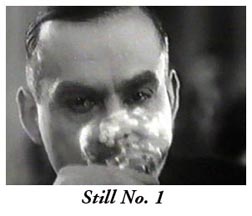
Comment: There is very little in the story, either for
the producer or the star to make capital out of, but the result
is a bright entertainment, and, perhaps fortunately for its success,
the volatile Betty is very rarely off the screen . . .
Production: The mounting is efficient in every way and
the photography excellent.
The photography and sets and décor certainly were up to the very best contemporary level. The ship exteriors were shot at Southampton on board the Berengaria. There was a general slickness and production value in excess of the usual British film of the period; but this cannot be properly gauged from the available version which is but a quarter of the original and is badly unbalanced both in interest (the first reel is far superior to the second) and in characterization.
Wholesale cutting, done only with an eye to preserving the continuity of the narrative, has made a hectic rush of the introductions and removed much interesting detail, besides leaving the ending obscure and making some incidents too brief to be readily understood at first showing - for example the affair of the dropped roll in reel 2.
Contemporary releases included "The Patriot" (by Lubitsch, with Emil Jannings, Paramount); "Tartuffe" (by F.W. Murnau, with Emil Jannings, UFA); "Laugh, Clown, Laugh" (by Herbert Brenon, with Lon Chaney and Loretta Young (her first film)); "The Crowd" (by King Vidor); and the early talkies, "Showboat" (Laura La Plante and Joseph Schildkraut) and "Coquette" (Mary Pickford).
The ingenious and apt opening shot is memorable; the camera sees through the eyes of a man drinking champagne; and as the precious liquid trickles down our throat we discern, through the bottom of the glass, a cabaret turn . . . Cut to C.S. of the drinker (still No. 1), the typical "Cosmopolitan" . . . He lowers the glass . . . Cut to continuation of the first shot, the glass lowered, he observes the end of the dance, then M.S. gives an objective view of his bored detachment.
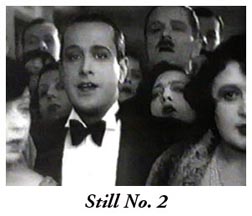 In L.S. people on the stair leading
to the restaurant talk excitedly, hurry away; diners get up, follow;
even the Cosmopolitan gets to his feet, a stationary figure in
a frame filled with movement.
In L.S. people on the stair leading
to the restaurant talk excitedly, hurry away; diners get up, follow;
even the Cosmopolitan gets to his feet, a stationary figure in
a frame filled with movement.
An exterior L.S. now discloses that we are on board ship;
the captain directs the lowering of a boat; passengers line the
decks; the boat pulls away . . . up to a seaplane. . . In the
door appears the cheerful Betty . . . She retreats and hands out
multi-labeled suitcases. This is a good gag, well "in character."
The seaplane wobbles realistically, but the general effect, including
the night sky and the shot of Betty in boat, with spray driving
past, is phony and reeks of the studio. This has always been a
Hitchcock weakness; one recalls the back of the tank in the shipwreck
scenes of "Jamaica Inn;" the toys in "Number 17"
(trains and Green Line buses); the queer unreality of the first
shot in "The Lady Vanishes"; 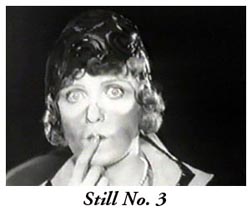 and
some parts of the seascape in "Lifeboat."
and
some parts of the seascape in "Lifeboat."
The boat comes alongside; passengers gape down from the rails at Betty, and Betty smiles back and "fixes" her hair. She climbs aboard - a face watching intently from a porthole enhances this shot - and faces a mob of passengers, into which pushes Jean (still No. 2), clearly the boy-friend. Finger to lip, she enjoins silence (still No. 3). Excellently, her face is blackened except where goggles covered it. Jean retreats. The Cosmopolitan watches it all with a quiet smile (sneer?). The young officer who helped her in asks, "Flying the Atlantic?" She replies, "Oh, dear, no - I just wanted to catch this boat." (Collapse of Y.O.)
Close-up of the New York "Daily News" shows headlines
devoted to the incident: WALL STREET MAGNATE AGAIN DEFIED BY HEADSTRONG
HEIRESS DAUGHTER . . . Gives Him the Air and Makes Freak Flight
to Join Lover in 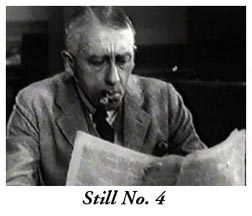 Atlantic Liner. In
CM.S., thoroughly narked, the Champagne King flings down the paper
and puffs fiercely at the cigar (still No. 4).
Atlantic Liner. In
CM.S., thoroughly narked, the Champagne King flings down the paper
and puffs fiercely at the cigar (still No. 4).
On board ship, Betty proves a considerable attraction, as the Cosmopolitan smilingly observes to a thwarted male; then, wittily, a title "Cupid at the prow, but Neptune at the helm" is followed by a L.S. of the restaurant, empty except for waiting waiters and the Cosmopolitan, and rolling under the influence of the same heavy sea that has taken such toll of the would-be diners.
The waiters sway in synchrony with the ship, or rather the camera, and Hitch and Jack Cox must have been pleased with the really excellent result. Betty then rolls (and pitches) in; and, with easily understood gestures in the full long-shot, the Cosmopolitan invites himself to her table.
In M.S. Jean approaches: his eyes narrow as he sees them, but he goes woozy all through as he also sees a stuffed pig's head (devilishly well selected for swaying, tracking detail shot) among the food, and he beats a hasty retreat up the swaying stairs.
A page delivers a cablegram to each of the diners; Betty's is from her father, and is terse . . . DOES LIFE MEAN NOTHING TO YOU THAT YOU RISK IT FOR THAT CAKE HOUND YOUR BOULEVARD SHEIK IS ONLY AFTER MY BANK ROLL - FATHER. Betty unimpressed; Cosmo is quizzical -- we are not shown his cable. Slow fade-out.
Betty lurches into Jean's cabin to show him the cable: he
looks up dizzily from bed and sees treble - excellently done,
three smiling, lurching Bettys (still No. 5). The cable cures
his sea sickness but adds to his irritation, which is fanned to
flame when Betty says: "I've arranged for the captain to
marry us." He gets up, complains about their 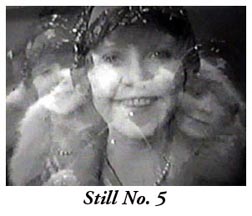 money
and manners, and Betty flounces from the cabin, but the effect
is spoiled by the rolling of the ship, necessitating two attempts
at opening the door.
money
and manners, and Betty flounces from the cabin, but the effect
is spoiled by the rolling of the ship, necessitating two attempts
at opening the door.
Hitchcock has handled this sequence admirably; with four titles and no inherent action, it presented a problem that was admirably solved by the arrangement, the choice of camera-angles, and the happy concluding "business" with the door, excellently executed by Betty Balfour - no easy task on a rock-steady set!
After a title explaining that the quarrel is still on, with
Betty in Paris having a good time -
(a) M.S. Betty appears through a door from among a mob of dancers,
smiles, dashes up and plants a kiss on the camera.
(b) F.C.S. Her father concludes his end of the kiss: TRACK back
to S.S.: he looks solemnly at her.
The idea of the kiss is well conveyed, but the shots suffer a technical fault that should have been remedied, in that the focus is disconcertingly lost at one point during each shot. The Champagne King takes his daughter into a private room and informs her they have lost all their money. Her reaction is brilliantly shown in one big close-up of her face with eyes shut, on which is faded in and out a superimposed mid-shot pan of the room, similar to the famous shot in the café in "Vaudeville," and as effective.
A tablecloth fills the screen and is lowered to reveal Betty preparing a meal in their now-humble room. She catches her hand under the tray. Her father sits down, looks askance at a bottle of wine she had laid in and starts on the impossible meal. The action here is uninspired (could inspiration save the threadbare situation?) and worsened by a lot of hearty talk from Daddy, which is particularly irritating in a silent film. He "doesn't feel hungry," goes away; Betty fed-up; C.S. : his plate with uninteresting scrap, MIX TO the remains of a good plateful; and, in a smart restaurant, he pushes it away . . . and the head waiter assists him in choosing something to follow . . .
Betty, covered in flour, is pastry-making when Jean bursts in; with a glad cry they embrace. In the CM.S. of the embrace, Jean's eyes rove round the room, then comes a mixed pan-and-tilt shot as the camera shows his line of vision. One notices again how good is the set, with typically French lattice-shaped wood hat pegs on the wall, and with plausible view through the window; the same may be said of the restaurant scenes, houses seen through windows being properly Parisian in appearance!
Jean says quite the wrong thing . . . "Now I've found you I'm going to take you out of this wretched place." - and starts up a new quarrel based on Betty's pride. The contrasted shots of the mounting row are well arranged and not without humour. Betty haughtily declares she'll get a job. Jean replies: "You'll make a mess of it as you do everything you lay your hands on." - then turns and walks out, and we are pleased to note two large white hand-marks on his shoulders, left by some pastry-making girl . . .
Betty spots an advert. for girls with perfect teeth to boost "Minto Tooth Paste" . . . We next see her in what is obviously a casting agency, where the boss asks, with a large gesture, "What brought you in here?" Betty is extremely indignant at the fellow's attitude, but manages to reply "Teeth!"
Then . . .
(a) CM.S. Boss retorts, with renewed gesture.
(b) TITLE "We are only interested in legs here."
(c) CM.S. (as a.) he says, and sits back.
(d) C.S. Betty explains:
(e) TITLE "I must have come in the wrong door - but it's
all the same to me if you can give me a job."
(f) C.S. Sinister-looking bloke leaning against door.
(g) M.S. The same; shot includes Betty talking to Boss (off).
(h) L.S. Bloke moves up to boss, whispers; Betty walks away but
boss hastily recalls her, says:
(i) TITLE "I'm interested in a cabaret - I can place you
there."
(j) C.S. Betty reflectively feels the shape of her nose, blinks,
smiles.
(k) CM.S. Boss dictates to secretary.
(l) C.S. Handwriting in shorthand on pad . . . MIX TO . . .
(m) C.S. letter being typed . . .
(n) C.S. Betty's hand takes envelope from secretary.
The boss scores well in his small part, and the camera-angle of (a) is just right - looking slightly down, as from Betty's eye. Betty's close-ups (d) and (j) are lit "all over" and sparkle; the bit of business in (j) is good from fan-appeal angle.
Shot (f) focuses attention on a typical Hitchcock minor character who was just noticed in the establishing long shots: and in (g) he swings his foot in a characteristic mannerism. We gather he has spotted the publicity angle of "Champagne King's Daughter Now in Cabaret," hence the boss's change of mind. (j) of course covers the time interval of secretary going up to boss. (m) is irritating in that what is being typed cannot be read properly, and (n) is infuriating in its measured slowness; Betty's hand pauses, takes letter, slowly withdraws; this smacks of "giving 'em time to understand" and is as bad art as any laboured explanation such as one finds in inferior detective-mystery films.
The whole sequence has been pruned, including the last shot, and we are dismayed to note the beginning of a further mix from shot (n) which is cut short by an abrupt cutting to blank film; then fade-in of L.S. Betty hands over the letter to head waiter in restaurant just as she is in the middle of fixing her up with a table for dinner, a neat touch. In CM.S his expression changes, and he looks her over . . . Cut-in shots of cloak-room indicate start of evening rush. Then very nicely,
(a) L.S. General view in kitchens, chef at work, waiters
carrying out trays in background,
(b) C.S. (detail) Chef's hands bundle rolls into basket; one drops
on floor, waiter's hand recovers it, dusts it carelessly against
his jacket, puts it back . . . MIX TO . . .
(c) C.S. (detail) waiter takes roll from basket with tongs and
carefully places it on diner's plate.
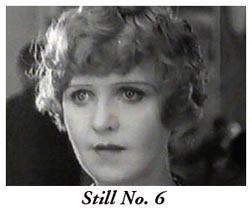 (d) L.S. The band strikes up.
(d) L.S. The band strikes up.
(e) F.L.S. (high angle) several couples dancing in the space between
tables; waiters moving to and fro.
(f) M.S. at bar, cocktail-shaker at work . . .
(g) C.S. Betty's eyes follow the shaking . . .
(h) CM.S. Cocktail poured out; shaker looks up . . .
(i) C.S. (as g.) Betty asks (still No. 6)
(j) TITLE "What do you call that one?"
(k) CM.S. (as h.) he replied
(l) TITLE "'A maiden's prayer'"
(m) C.S. (pan) It gets taken away on a tray . . .
This little sequence admirably crystallizes the atmosphere of the restaurant, and the shots are excellent in choice, content, and photography. The roll gag is delightful; the careful handling in (c), contrasting with the crude wiping in (b), has the added perfection that in each case the action occurs in exactly the same point in the frame. (e) is a grand shot, especially for the 1928 period.
(f) has a really good background of extras, well grouped and looking as though they belonged. (g) has a good directorial touch in that Betty's eyes follow the hectic shaking. The question-and-answer may be uncinematic, but they are particularly apt, since the cocktail is next seen to reach up at the hand of our ship-board friend, the Cosmopolitan.
We see him in an excellent tracking shot. Approaching in-between dancers to his lone table; in startled CM.S. Betty has seen him, and in contrasted CM.S. maiden's prayer in hand, he smiles at her. They join, she with basket of flowers - at work . . . M.S. of packed dancers mixes to a tight mob of sheep and back to dancers (in 1928 this gag had not yet scored its century) and Betty and Cosmo are now seated together; he says earnestly "Don't you realize that anything could happen to a girl like you in a place like this?"
A sinister close-up shows his eyes staring over the rim of a champagne glass: she looks startled, but we now cut to L.S., Jean enters. Betty sees him, waves. He comes up. Cosmo greets him cordially, but is cut dead. He sits beside Betty. (The film tottered at the last quoted title, but in this sequence it crashes completely: over-pruning has sunk the ship by destroying character motifs and failing to establish the relationships essential to the proper denouement of the story. However, we have had a good reel and a half, so many perhaps are thankful.)
Cosmo writes a note: Always your good friend if you are
in need, and gets up and goes. Jean is startled, Betty explains
she works there; cut-in L.S. of another flower-girl 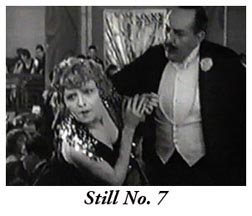 suffering
the attentions of a gentleman with a beard; C.S. Jean dismayed
(over-acted); C.S. Betty laughs, puts over a bit of jazz stuff
(she got rhythm), but Jean seizes her wrists, new argument starts,
he goes - dramatically done by suggestion in a shot showing Betty's
reaction: she pushes frantically after him through the dancers,
but is intercepted (still No. 7) by the head waiter; and he walks
out through the swing doors . . . Fade-out.
suffering
the attentions of a gentleman with a beard; C.S. Jean dismayed
(over-acted); C.S. Betty laughs, puts over a bit of jazz stuff
(she got rhythm), but Jean seizes her wrists, new argument starts,
he goes - dramatically done by suggestion in a shot showing Betty's
reaction: she pushes frantically after him through the dancers,
but is intercepted (still No. 7) by the head waiter; and he walks
out through the swing doors . . . Fade-out.
Fade-in, he returns with the Champagne King, in a curiously ill-composed shot that shows mainly blank wall. Exaggeratedly, in M.S. as the two approach, Betty prances smoking, giggling and jazzing with a colleague down a flight of stairs. The men are Not Amused, and approach grimly: in L.S. they come up, the effect being ruined by a wall-lamp appearing to be resting on Betty's head, an unhappy error of camera-angle.
Daddy tells her off, then explains the hoax by handing her a newspaper cutting DARING DAUGHTER TO BE TAUGHT LESSON SHE'LL NEVER FORGET, MILLIONAIRE DECLARES. Furious, she tells them what she thinks ( an excellent angle this time, the men framing the shot) and flings off upstairs.
Via a mix from the Cosmopolitan's note to his card and doorbell, Betty calls to find him almost off to America, which is Too Marvelous: by yet another abrupt cut they walk up the gangway and . . . MIX . . . enter a double stateroom. The lighting is incredibly bad, with shadows over the floor and complete lack of contrast or depth. Cosmo goes out: Betty tries the door and finds it locked: tears a bar from a towel-rail: the door opens, man enters, she belabours him - it's Jean!
Explanations, kisses, then he hides in bathroom: door stealthily opens again, Cosmo enters, Betty fakes a smile, but then Daddy follows him in, Betty is astonished: Cosmo is introduced as an old friend, and he produces his cablegram in explanation: BETTY ON BOARD YOUR BOAT TRYING TO ELOPE PREVENT MARRIAGE ALL COSTS ELOPE WITH HER YOURSELF IF NECESSARY CAN TRUST HER TO YOU -- MARK. All laugh. Jean bursts out from the bathroom just as Cosmo has a platonic arm around Betty, so makes a dive at his throat: but is pulled off by Daddy and a champagne-bearing steward, and Betty explains . . . THE END.
The dramatic, artistic, narrative and photographic debility that descends to wreck the last quarter of the available version is just as useful a lesson in Cinema as many of the excellencies of the earlier parts of the film. A logical climax, even in Hitchcock's attenuated later style (cf. "Shadow of a Doubt"), must exist in the conclusion of a narrative; and if there is any patchiness in technical quality, the best should come at the end. This should always be checked before putting a scenario into production. One can quote numerous cases of a brilliant climax saving a banal film; "San Francisco" is a classic instance, Gable, Tracy, MacDonald did what they could with the first seven reels, then the earthquake saved the picture.
It is pleasant to look back at "Champagne" and learn from the good and the bad in it; and even pleasanter to reflect that its grandly individualistic and competent director is still at work, with an even surer touch.